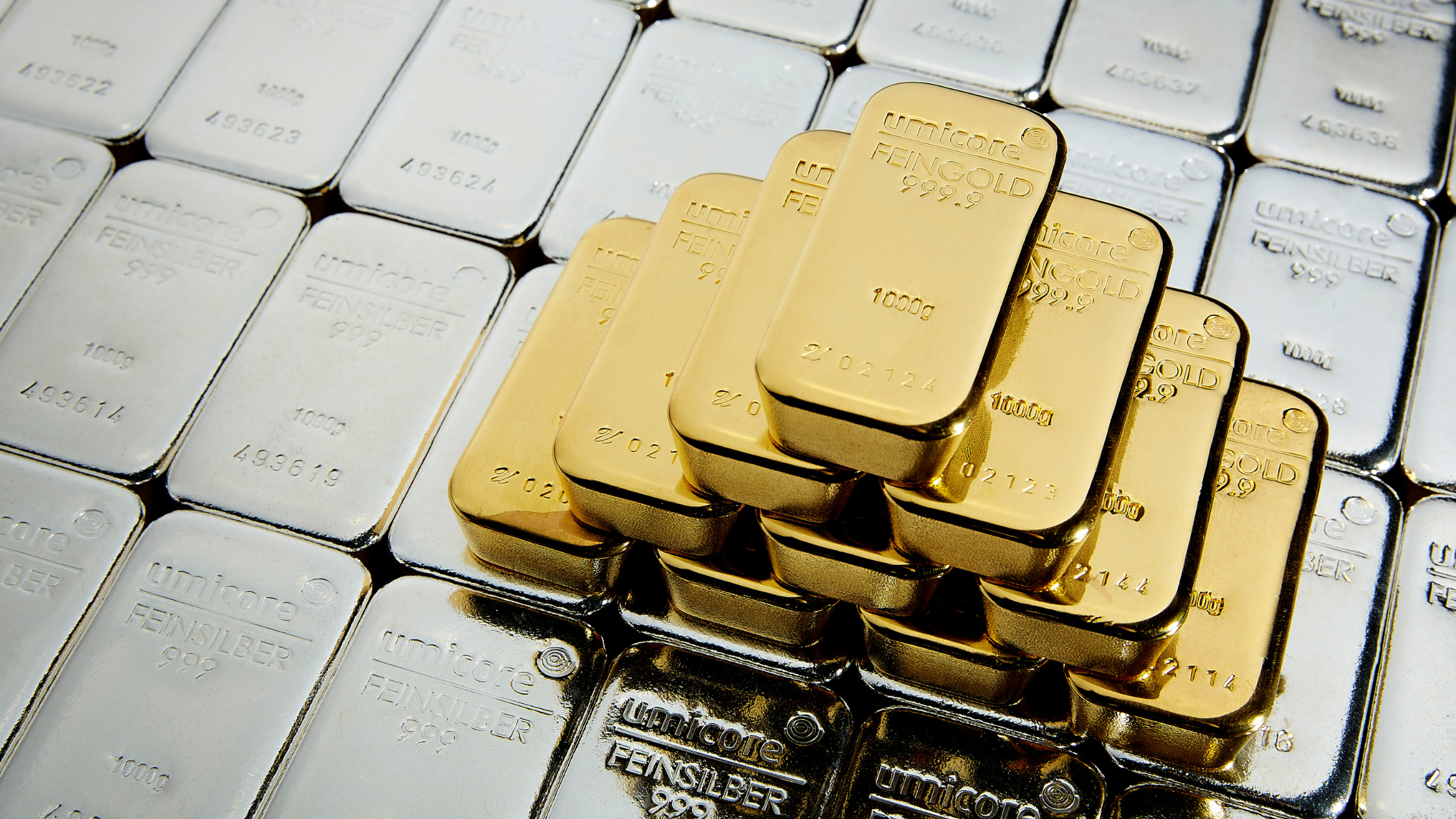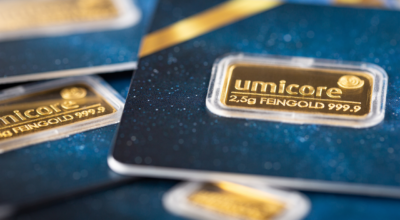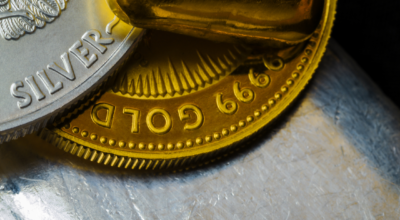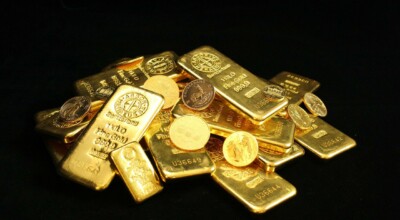Gold and Silver Bars from Umicore. Image: Umicore
Silver’s Upside Potential and New Rules for Gold
- Kitco: The silver market deficit and price manipulation will eventually lead to triple-digit prices.
- MoneyMetals: The gold/silver ratio is historically high and will likely return to its average quickly despite price manipulation.
- Von Greyerz, Gold Switzerland: The new rules for gold and five reasons behind them.
Kitco: The silver market deficit will eventually lead to triple-digit prices
The silver industry is experiencing significant manipulation due to its dual role as an industrial metal and an investment asset, claims First Majestic Silver CEO Keith Neumeyer in an interview with Kitco News. He emphasizes that major banks’ trading desks treat silver merely as a number on a screen, ignoring its fundamental value. Neumeyer told Kitco News:
“These traders, as I once was, don’t understand that it’s an important metal that should be traded at a much higher price.”
The global silver deficit is expected to grow by 17% and reach 215.3 million ounces by mid-July 2024, driven by increased industrial demand and decreased supply. This ongoing deficit highlights silver’s critical role in various industries, including electronics, solar panels, and electric vehicles. Neumeyer underscores silver’s strategic importance for technology and renewable energy development. The silver market has had a structural deficit for four consecutive years, with the current deficit at 240 million ounces.
Institutional investors have largely overlooked the silver market despite its crucial economic role. Major institutions, such as the Canadian pension system, do not hold significant positions in silver or mining stocks. This lack of institutional support is seen as a missed opportunity, leaving the market mainly to retail investors and smaller players.
Neumeyer predicts that silver will reach triple-digit prices due to persistent market deficits. He believes the potential for triple-digit silver prices is based on its essential role in green energy and industrial applications. Neumeyer remains optimistic about silver and other commodities and urges investors to consider this sector seriously.
MoneyMetals: The gold/silver ratio is historically high and will likely return to its average quickly despite price manipulation.
Money Metals’ Mike Maharrey writes about the imbalance in the gold/silver ratio. He notes that a few months ago, the gold/silver ratio broke an important support level, indicating that the white metal might be closing the gap with gold.
The gold/silver ratio indicates how many ounces of silver are needed to buy one ounce of gold, considering the spot prices of both metals. In other words, it shows the price of gold in ounces of silver. According to the MoneyMetals article, the gold/silver ratio is 76-1 (at the time of writing, the value is 85). This means 76 ounces of silver are needed to buy one ounce of gold.
The ratio is still historically high, meaning silver is undervalued compared to gold. The article suggests signs that the trend is reversing. The gold/silver ratio has historically averaged between 40-1 and 60-1. When the ratio rises significantly above this historical average, it tends to quickly return to the average. For example, in 2020, the gold/silver ratio hit a record 123-1 during the global COVID-19 panic and then fell to about 60-1 when central banks worldwide started printing money to sustain their economies.
Silver has significant upside potential
According to the article, silver might be poised for a significant rise as scenarios look bullish for gold with the likelihood of interest rate increases. Silver demand is also at record levels, but supply has stagnated. Silver demand is expected to reach 1.2 billion ounces this year, which would be the second-highest annual silver demand ever. Current supply forecasts considering the demand level would cause a structural market deficit of 176 million ounces. This would be the fourth consecutive year where demand exceeds supply, further depleting global silver inventories.
Based on the fundamentals of demand and supply and the technical breakdown of the gold/silver ratio, it may be an excellent time to buy silver at the beginning of an upward trend, writes Money Metals’ Maharrey.
The Invisible Hand Affects Silver Prices
In another article, Money Metals’ Brien Lundin, Gold Newsletter writer, addresses the failure of silver prices to keep pace with gold prices and suspects manipulation, possibly by investment banks and the government.
JPMorgan Chase, the custodian of the silver ETF SLV, has previously manipulated markets and paid significant fines, including a $920 million fine for manipulating metal markets. Lundin claims that suppressing silver prices has been U.S. policy since 1965 when silver was removed from currency. President Lyndon B. Johnson warned against hoarding silver coins, but inflation increased their value, leading to hoarding.
JPMorgan Chase’s close ties to the U.S. Treasury Department and role as a custodian of major ETFs like SLV and GLD have raised suspicions of government involvement in market manipulation. Although JPMorgan executives deny this, evidence presented in a 2020 trial showed that central banks, including the U.S. government, are significant players in metal markets.
According to Lundin, an “invisible hand” appears to influence silver markets similarly to gold markets, which he believes indicates systematic price suppression efforts.
If you’re looking to buy silver and take advantage of its growing upside potential, now could be a strategic time to consider adding it to your investment portfolio.
Von Greyerz, Gold Switzerland: New Rules for Gold and Five Reasons Behind Them
The rise in gold prices this spring has been remarkable, writes Jonni Stoeferle of Von Greyerz. In just a few weeks, gold prices rose nearly 20% in U.S. dollars, with a 21.7% increase in the first half of the year alone. In euros, gold prices rose 16.4% in the first half of the year.
Under previous rules, gold prices should have fallen. The collapse of the correlation between gold prices and real interest rates raises many questions. Under the old model, it was unthinkable for gold prices to strengthen during a sharp rise in real interest rates. Gold and gold investors are now entering terra incognita, uncharted territory, claims Von Greyerz in their article.
Growing demand for gold raises prices along with rising real interest rates
Von Greyerz notes that the once-strong negative correlation between gold prices and U.S. real interest rates and the strong link between Western investors’ demand and gold prices have disappeared in recent quarters. Thus, Western financial investors are no longer the marginal buyers or sellers of gold.
According to the article, significant demand from central banks and private Asian investors is the main reason gold prices have performed well despite rising real interest rates.
Interest in gold continues to grow in the global East
Secondly, the global East is becoming increasingly important. This is not surprising, considering the West’s share of the world GDP continues to decline with slowing growth and an ageing population. Additionally, many Asian countries have a historical affinity for gold.
Interest in gold is growing in China: China is discovering gold as an alternative retirement asset due to structural problems in the real estate market. Gold nuggets are currently trendy, especially among Chinese youth. Strong demand for gold from Asian central banks is also a significant driver of this change.
Central banks’ share of total gold demand is growing
Thirdly, central banks’ demand surged significantly after Russia’s foreign reserves were frozen after the outbreak of the Ukraine war. As a result, central banks’ gold demand reached a new record high of over 1,000 tons in 2022, just narrowly missing this level in 2023. Q1/2024 was the strongest first quarter since records began.
Therefore, it is not surprising that central banks’ demand share of total gold demand has significantly increased: from around 10% between 2011-2021 to nearly 25% in 2022 and 2023. Geopolitical instability is the third most important reason for central banks’ investment decisions. And geopolitical instability is expected to continue for some time, according to the article.
A major debt crisis could affect leading industrial nations
Fourthly, the situation is influenced by the growth of total debt by states, corporations, and households. According to the article, Japan leads with a “dishonorable” top position with a debt ratio slightly over 400%. France is second globally and first in Europe with 330%, making it a much bigger problem child than Italy, often criticized in the media. Italy’s total debt is about 80 percentage points lower.
The uncertain political situation following the surprising victory of the far-left New People’s Front in France’s presidential elections exacerbates France’s debt situation. In the United States, the ongoing extremely loose fiscal policy results in a massive debt problem, with no quick relief expected due to the elections. The next major debt crisis could, according to Von Greyerz, affect some leading industrial nations.
Alternative asset classes for investment portfolios
Fifthly, the article recommends a change in the traditional investor portfolio allocation (60/40). The author argues that the investment environment for gold investors has fundamentally changed. The reorganization of the global economic and political order, the dominant influence of emerging markets on gold markets, the limits of debt sustainability, and potentially several inflation waves will increase the value of gold.
Besides gold, the article sees other alternative asset classes, such as commodities and Bitcoin, as important in investment portfolios under the new rules for gold. According to the author, a suitable portfolio consists of 60% stocks and bonds + 40% alternative asset classes.







